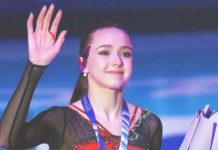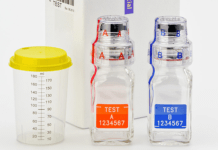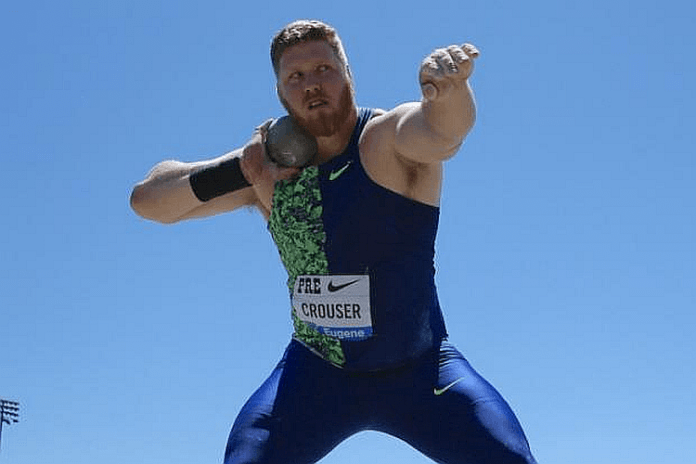(For part one of our Team USA Media Summit review, click here)
/Updated/Last week’s online Team USA Media Summit gave Olympic and Paralympic athletes and hopefuls a chance to chat with news media from around the world. In part two of our review, here are some of the most noteworthy highlights (these are from the closed-caption transcripts, with errors corrected as identified).
These are U.S. Olympians-to-be (already qualified), or leading U.S. contenders; what they had to say was pretty interesting:
ATHLETICS/Michelle Carter, 2016 women’s Olympic Shot Put gold medalist:
● “ I would say winning a medal does help raise your profile, but I just kind of fell into the things that I loved to do, that I was already doing prior to winning. I have a youth camp where we build up the confidence in young female athletes to believe that they are great in who they are, on and off the field.
“So having a different platform can do that, and bring more eyes to the cause and to the nonprofit and one golden shot, and it has definitely helped, because for me, I definitely want to use my gift and pour that into others, especially the next generation, so that’s what I have spent time doing, and bring awareness to the issue with the young female athletes and female athletes in general. I guess that’s how I raised my profile by using the platform to help build up those who are around me, and those I get to touch and interact with on a regular basis.”
ATHLETICS/Ryan Crouser, 2016 men’s Olympic Shot Put gold medalist:
● “It was Monday afternoon [in March 2020], an e-mail came down from [the athletic department], saying you guys got to be out by 5 p.m. today. So that evening, I was at Home Depot buying plywood and getting in contact with track and field suppliers to build my own portable shot put ring and just kept that in the back of my truck, and would go to the elementary school by my house and would throw off this vacant lot. got some weird looks.
“It was around a jogging trail; people would come by and there were lot of comments with that. Pretty entertaining. … I was in [my coach’s] bigger garage with higher ceilings and he’s been really generous letting me lift in there, so I’ve been in there since March and still do half my workouts there when I can’t fit them in at the University of Arkansas.
“Probably the most unusual is med ball’s a big part of throwing, just developing rotational power and strength, so I’ve been doing my med-ball workouts underneath a bridge [between] the concrete supports. That also gets unusual looks. I’m on the same trail I’ve been throwing at off the sidewalk, so people see me throwing one way, and when they are running the other way they will see me throwing a med-ball into a concrete support. It’s definitely been a lot of improvising and figuring out ways to get what I need done, but I’ve enjoyed the challenge in the sense that I feel like I’ve been able to make a system that works for me.”
● “A touch on diet a little bit. I’m a big guy: 6’7″, around 320 and I’m always trying to maintain that weight. For me, it is difficult to keep my weight up. I hang around 5,000 calories a day to maintain, and do that over four or five meals, and my normal meal is a thousand calories.
“If you think of what the average person should eat in one day, take half of that and that is one of my four to five meals for a thousand calories. Four to five meals a day, a thousand calories each and the rest filled with snacks, and that is how you get to be 320 pounds.”
● “We’ve done lot of work with radar technology, that is used to track the shot. It is the same or almost the exact same technology that you see in golf and the telling you how far the drive goes. So it is tracking the shot, and it will give you release angle, velocity, you don’t have [golf] spin really on the shot, you don’t have wind resistance, so it makes it actually easier to track and you are just following projectile motion.
“So we use that technology and … where you make progress is reconciling the sports science side of things along with the throw-specific side of things, because you have physics telling you that 45 degrees is farthest, optimal for projectiles. But the human body throws a shot little better at 38-40 degrees, and for me personally, I seem to throw a shot better at 36 degrees. So just kind of figuring out how can we pick up distance using this analysis without getting too in-depth and just committing blindly to it. So that is kind of the art form to it.”
CANOE-KAYAK Sprint/Nevin Harrison, 2019 women’s C-1 World 200 m Champion:
● “Leading up to the Games, I will be over on the East Coast and it hasn’t been my favorite just because I love my [Seattle] home so much, but it’s been worth it. You know, we put so much hard work in we hardly have time to look around and see where we are.
“So, you know, it’s training and resting and kind of the daily schedule for me, obviously, I imagine for these women, too, so it’s been hard. It’s been challenging to be away from my family, away from my friends. I started training here when I was 17, so about a little over a year ago, so, it was definitely a hard transition for someone that was supposed to be a senior in high school and doing all those things, going to prom and having the regular life.
“I was living pretty much alone in training and competing, traveling all over the world and [then] Covid hitting me; everything slowed down a lot and maybe spending a lot more time in [her training base in] Georgia than I expected to.”
(Special thanks to reader Jean Folger for straightening out Harrison’s comments from those of Evy Leibfarth, following below.)
CANOE-KAYAK Slalom/Evy Leibfarth, 2018-2019 women’s U.S. K-1 champion:
● “I do buy my boats; when I travel, we check it in oversize [with airlines]. We are lucky to have that, you really hope it doesn’t get broken of course, things do happen. You kind of have to be prepared for that and have a back-up plan, but you saw those and I’m sure they’re all very customized, like this is the thing for you. So it is very hard to find another boat if that doesn’t happen or if you are not able to get it on the plane.”
DIVING/Kassidy Cook, 13th in the 2016 Rio Olympic women’s 3 m springboard:
● “I think what brought me back [in 2019] was just missing the sport, and feeling like I was regretting it if I didn’t at least try once more. After I graduated from college [in 2018], I was coming off a couple of injuries, I had had my third shoulder surgery the summer before my last season, and you know, my body was kind of exhausted and I got the senior-in-college feeling: what do I do for the rest of my life, I need to get a job and working and set myself up for after sports and I think the pressures combined with the toll that it took on my body ultimately led me to the decision to retire.
“But actually, with the retirement, I started feeling really good and working out and got into really good shape and I went and watched the USA team, which was in California, and the first time I went to a meet as a spectator and I was watching them, and it really made me miss it, and I was like, okay, like I think if I trained back, and you know, I quit my job, packed up from San Francisco and moved back to Texas to train with my coach that I went to the 2016 Olympics with, and the rest is history.
“I just really miss the sport and I knew that, you know, I’m able to dive and be an Olympic athlete for such a short period of my life and these years are special to me and I would regret if I wouldn’t at least try to go to the Olympics.”
● “For me, personally, when I’m Zooming mock competitions in practice, I do get that adrenaline and the nerves going, sometimes more than [an actual] competition,, because in a competition, you have a lot of downtime, [and] in between doing dives, you can calm yourself down, but in a mock meet, you don’t have that time, so you’re definitely thinking and definitely the nerves and the adrenaline are going. … It is really hard to replicate what it feels like in a competition so to be able to do that, you know, on a regular Friday during practice is really cool.”
FENCING/Alex Massialas, 2016 Olympic Foil bronze medalist:
● “When the [Stanford sports] cuts were announced, one of the first thoughts I had was that this would be, you know, devastating to not only the fencing pipeline – not just because Stanford has strong programs on the West Coast for fencing – but it sets an example among all of the rest of the NCAA schools as to how to have successful programs while also maintaining academic and athletic excellence across every single sport. …
“I was speaking with a lot of USOPC members and members of the Athletes [Advisory Council] over there, and their worry was that in eight years we would really start to see the effects of these cuts and as we can see that, since Stanford announced their cuts, we’ve seen so many other schools follow suit, and even have schools plagiarized Stanford’s announcement to cut sports.
“So it just shows that Stanford’s such a leader in these sports, and in this area right now, it is extremely dire, and I think everyone can acknowledge that at times the NCAA model is broken and that’s why there’s so many different people, so many different organizations, trying to fix this model and what we’re trying to do as alumni, what I’ve been trying to do is try to do that from within Stanford, to do it within the first school, to start with, and then hopefully, we can set the base, and really lead when it comes to building a successful platform for NCAA sports and Olympic sports moving on into the future.”
GYMNASTICS/Sam Mikulak, 2-time Olympian & 6-time U.S. All-Around champion:
● “What has changed the most [with the postponement] is the amount of time that it takes for me to be able to go in the gym and be [able] to continue doing the sport at a high level. Really what I was telling myself before, is I was younger and healthier of course when I was making those statements, but what has happened is, as I took like three months off in gymnastics and then I started coming back I realized how much harder it is to come back and do all these high-impact events and be able to do that safely because I started getting a lot of small injuries that just kept nagging and getting worse. …
“It was just becoming clear that my body can’t hold up and really the only way I’m able to keep going right now is because I’m doing about at least an hour of manual treatment every day, an hour of rehab a day, an hour of strength and conditioning and then I have to do gymnastics, and I think the big change is that I never had to do all of that just to be able to do gymnastics. Now it’s like, here’s my final push, I’m going to give it everything I’ve got the way I’ve always done it. The task on my body is so much more now than it’s ever been before and I just don’t want to do this for another three more years.”
SKATEBOARDING/Bryce Wettstein, 2019 U.S. women’s Skateboard Park champion (age 16):
● “The competition in the Games is, I think honestly, going to enlighten skateboarding a little more than ever because I think skateboarding has been known as this dynamic art. It’s basically kind of something that people illustrate, and it’s very fluid. There’s nothing that rigid about what skateboarding has to be and what it is. I think it’s a sport that makes you feel very introspective about yourself, and I think putting on a competition with a high platform, you’re finally meshing the art and the sport together, which is completely enhancing.
“I think skateboarding, people now know, that it doesn’t have to just be restricted as an art or a sport, it can be both. And the competition in the games, I think it’s really going to fulfill skateboarding and let everyone know you can do it because it doesn’t have to stick to one thing. It can be an art and a sport together … I think the competition is definitely going to light up skateboarding because it’s going to basically lift away the boundaries people thought were around skateboarding.”
● “Honestly, I can say that it means more than the world to me to be part of it because I think the first time just the notion that skateboarding was being drafted as a sport in the Olympics was already kind of mind-boggling to all of us.”
SOFTBALL/Haylie McCleney, 2016-2018 World Championships gold medalist (outfielder):
● “I think for our sport to be on the biggest stage in all of sports is extremely critical. For us, we want to constantly get our game in as many living rooms and as many family rooms and … wherever you are in the world, we want you to be able to watch and having access to our sport. It really is a beautiful sport.
“I think when you put softball on the biggest stage, more little girls will want to play it, more little girls will want to sign up, more little girls will want to come into our sport, realize how many life lessons they can learn from it. They will want to be us. That’s the point of us playing. I’m not playing right now so I can say I went to the Olympics in 2021. That’s not why I play. I play to give more women more opportunities, to give young women opportunities, like, we’re already thinking about essentially getting back in the [Games] in 2028 as well, in L.A.”
● “We need to, I think, get our sport in the eyes of more European countries to be honest and they hold a lot of votes in the IOC as well, so getting our game in front of people that have a vote and a say is critical. If those people were to give us a chance, I guarantee they will like what they see. They’re going to want to keep us in the Games full time.
“Our sport is literally the best sport, so many life lessons, so many women that played it, it deserves to be in the Olympics full time. We don’t have a lot of professional opportunities. This is our biggest stage and we, to be blunt, we fight like hell to make it you know the best sport and a real experience for people that actually watch it. So, I like where we’re headed, I think we are doing a lot of good things in sport. … We’re not in a European country. Go figure.”
● “It’s crazy to me to play a sport, to dedicate my life to a sport, to train as hard as I do, as seriously as I do, and then to not be rewarded for it as like if I was a man, I would be rewarded for it. It’s very, very difficult.
“You know, most people don’t know, we have to have two or three side jobs to make a decent living so we can train to play our sport. It’s mind blowing for us. I think it’s that way for a lot of other women’s sports as well. There is just not a lot of professional opportunities in the United States.”
SWIMMING/Katie Ledecky, five-time Olympic gold medalist (2012-16):
● “I actually graduated in the fall, this past fall [2020] I, as you said re-enrolled in classes at the start of the pandemic. The start of spring quarter at Stanford coincided perfectly with the postponement of the Olympics and the pandemic. I had been taking the 2019/2020 Olympic year off, and so in March of 2020 I was able to hop back into classes, virtually, and finish up my degree.
“It was great to have that to keep my mind occupied and to complete my degree earlier than I expected. It was a really nice silver lining for 2020 and I took some really interesting classes in the spring, which was right at the beginning of the pandemic. I took a class called ‘Global Change and Emerging Infectious Disease,’ and that class was scheduled before the pandemic really broke out. So they really adapted the class to focus on coronavirus … and so we got a little insight and it was really neat to just hear from experts. … I majored in psychology and finished up a minor in political science as well.”
● “I turned pro in April of 2018 coming off of my second national championship with Stanford, and … I am very happy with that decision. I’ve been able to continue to train with Stanford, the collegiate team along with a handful of professional swimmers who swam for Stanford, so we have … our little professional group as well as the Stanford swim team. It’s just a great team to be a part of and I feel very fortunate to have had the best of both worlds, really, to be able to compete for a college and really get that experience of having those friends, having those teammates. I have friends for life on that team.”
● “I haven’t seen my family in over a year, not one family member, so it is coming soon and I’m really excited about that.”
● “I’m not planning on competing in the 100 [m] Free in Tokyo, but I am working towards swimming the 200, 400, 800 and 1500 [m] and hopefully the 4×200 Freestyle relay as well. With the addition of the 1500 Free, there is the potential that there will be the prelims of those races … in the same session for the women, and the 200 and 1500 Free finals are also in the same session.
“So that is a little bit of a challenge for me and something I’m really trained for. I would point out the males don’t have that double. … but I am excited for the challenge and excited to really show my range and have that opportunity to both, you know, compete hopefully in the shorter races like the 200, which I swam in Rio and also in the 1500 for the first time at the Olympics for women, which is extremely exciting and just something that I want to kick off the U.S. on a good note for that race.”
TABLE TENNIS/Nikhil Kumar, 2019 Pan American Games men’s Team gold medalist:
● “So for me a day’s a little different than many of the professional athletes given that I’m still in high school [age 18]. Normally for me, I’m going to school during the first half of the day and 12:30, 1:00, I’m done with school. From then I end up going to a training club near my area in Santa Clara [California] and over there I start training about 3:30 or 4:00 in the afternoon, normally playing with my coach and other training partner.
“Most of it is on the table, training where I’m practicing, like different drills and putting the ball different locations on the table for about two to three hours every day and then after that I also do some physical training which involves normally like some cardio, a lot of agility and speed, change of direction, and then also some weight and resistance training too.”
TRIATHLON/Summer Rappaport, four-time World Triathlon Series medalist:
● “My NCAA career is actually what pushed me towards triathlon. My collegiate swim coach [at Villanova] put me in touch with USA Triathlon, and it let my Olympic dreams be realized … to be honest, I always struggled to pick up biking, especially in the beginning. But I’m somebody that doesn’t accept defeat, so I kept coming back every day even when it was really difficult, and here I am now.”
● ”I have tried to fill that [no-racing] gap with some race visualizations [that] I worked on with my sports psychologist in [2020] as we definitely tried to incorporate some aspects of racing that we weren’t worried about in 2019. I raced once in 2020 at the Hamburg World Triathlon Series event and I was really surprised at just how hard racing felt, so we really worked on incorporating some of the feelings of going hard and other feelings and emotions I remember feeling in that race that I was surprised about, so it won’t be as much of a surprise when we return to racing in the coming months.”
VOLLEYBALL-Beach/Alix Klineman, world-ranked no. 1 with April Ross:
● “I think we had a lot to gain from this extra time [from the postponement]. Obviously I’m really new to the beach game and to have an extra year has been a lot more time to keep learning and kind of bonding as a team.
“I also was able to get a little healthier too. I took a lot of that down time and trusted my physical therapy and things like that. I feel like we’re in a pretty good position after the pandemic and we’re really excited to get back on the court and looking forward to Tokyo.”
VOLLEYBALL-Beach/April Ross, 2012-2016 Olympic medalist:
● “I never really had a plan for after Tokyo, it was supposed to happen when it was supposed to happen. But now that there’s only three years between Tokyo and Paris it seems more attainable to do three more years. There are other things i want to do in life, so I might try to do those and see how things go, but I don’t want to retire prematurely.
“Physically, I feel great, still love competing, and I would love to go to Paris for the Olympics and like [U.S. men’s player Matt Anderson] said, have my family be able to be there if that’s going to be my last one. I think I will go forward with the intent of competing in Paris now that it’s only three years away … that is my argument with my husband all the time. …
“It can go quick. I have three kids, my oldest is 10 and I’m hoping that by Paris they can all come along and I hope if everything goes as planned and again still being worthy of being on the team, going out on home soil in L.A. would be really awesome. I don’t know that my husband is on board with that, though; we’re working on it.”
WATER POLO/Maggie Steffens, two-time Olympic gold medalist (defender):
● “For us, right now, we don’t get a chance to play games, but luckily, with this day and age, there’s a lot of video online, so there have been European games the past few months, there was the qualifier tournament for Europe, so we’ve actually been able to watch a lot of our competition online and been able to scout them from our computers.
“A little bit different than getting to play them physically and have the emotions involved, and have somebody grabbing your suit, and something you will remember when the game comes, but we have been really capitalizing on preparing our own team and making sure we’re the best Team USA, the most prepared Team USA we can, and competing against each other at the highest level at our training in SoCal, and then at the same time, making sure we are scouting these other team, watching old video, watching new games, being able to even like see each other’s faces on-screen reignites that competitive energy, that obviously [keeper] Ashleigh [Johnson] and I are craving, but we’re still able to get it, and we can be intelligent now with our scouting, just in a different way.”
Still one more column to come of comments from U.S. stars of this coming summer.
Rich Perelman
Editor
You can receive our exclusive TSX Report by e-mail by clicking here. You can also refer a friend by clicking here, and can donate here to keep this site going.
For our 649-event International Sports Calendar for 2021 and beyond, by date and by sport, click here!
















